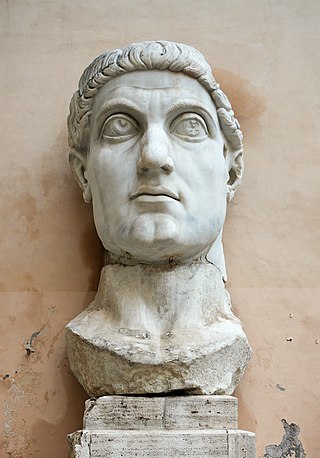
Constantine I, also known as Constantine the Great, was a Roman emperor from AD 306 to 337 and the first Roman emperor to convert to Christianity. He played a pivotal role in elevating the status of Christianity in Rome, decriminalizing Christian practice and ceasing Christian persecution in a period referred to as the Constantinian shift. This initiated the cessation of the established ancient Roman religion. Constantine is also the originator of the religiopolitical ideology known as Constantinianism, which epitomizes the unity of church and state, as opposed to separation of church and state. He founded the city of Constantinople and made it the capital of the Empire, which remained so for over a millennium.

The labarum was a vexillum that displayed the "Chi-Rho" symbol ☧, a christogram formed from the first two Greek letters of the word "Christ" – Chi (χ) and Rho (ρ). It was first used by the Roman emperor Constantine the Great.

Valens was Roman emperor from 364 to 378. Following a largely unremarkable military career, he was named co-emperor by his elder brother Valentinian I, who gave him the eastern half of the Roman Empire to rule. In 378, Valens was defeated and killed at the Battle of Adrianople against the invading Goths, which astonished contemporaries and marked the beginning of barbarian encroachment into Roman territory.

Year 316 (CCCXVI) was a leap year starting on Sunday of the Julian calendar. At the time, it was known as the Year of the Consulship of Sabinus and Rufinus. The denomination 316 for this year has been used since the early medieval period, when the Anno Domini calendar era became the prevalent method in Europe for naming years.
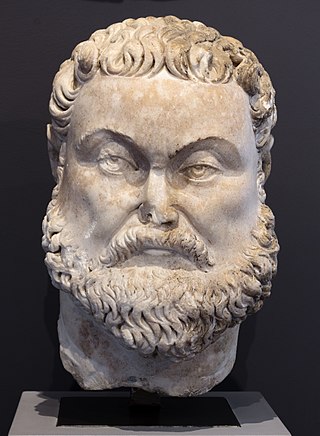
Maximian, nicknamed Herculius, was Roman emperor from 286 to 305. He was Caesar from 285 to 286, then Augustus from 286 to 305. He shared the latter title with his co-emperor and superior, Diocletian, whose political brain complemented Maximian's military brawn. Maximian established his residence at Trier but spent most of his time on campaign. In late 285, he suppressed rebels in Gaul known as the Bagaudae. From 285 to 288, he fought against Germanic tribes along the Rhine frontier. Together with Diocletian, he launched a scorched earth campaign deep into Alamannic territory in 288, refortifying the frontier.

Marcus Aurelius Valerius Maxentius was a Roman emperor from 306 until his death in 312. Despite ruling in Italy and North Africa, and having the recognition of the Senate in Rome, he was not recognized as a legitimate emperor by his fellow emperors.

Flavia Julia Helena, also known as Helena of Constantinople and in Christianity as Saint Helena, was an Augusta of the Roman Empire and mother of Emperor Constantine the Great. She was born in the lower classes traditionally in the Greek city of Drepanon, Bithynia, in Asia Minor, which was renamed Helenopolis in her honor, although several locations have been proposed for her birthplace and origin.
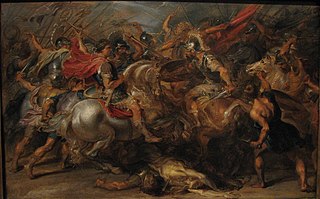
The Battle of Chrysopolis was fought on 18 September 324 at Chrysopolis, near Chalcedon, between the two Roman emperors Constantine I and Licinius. The battle was the final encounter between the two emperors. After his navy's defeat in the Battle of the Hellespont, Licinius withdrew his forces from the city of Byzantium across the Bosphorus to Chalcedon in Bithynia. Constantine followed, and won the subsequent battle. This left Constantine as the sole emperor, ending the period of the Tetrarchy.
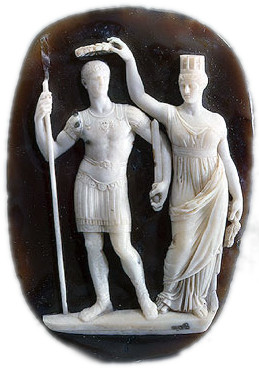
The Battle of Adrianople was fought in Thrace on July 3, 324, during a Roman civil war, the second to be waged between the two emperors Constantine I and Licinius. Licinius was soundly defeated and his army suffered heavy casualties. Constantine built up military momentum, winning further battles on land and sea, eventually leading to the final defeat of Licinius at Chrysopolis.

The Battle of the Hellespont, consisting of two separate naval clashes, was fought in 324 between a Constantinian fleet, led by the eldest son of Constantine I, Crispus; and a larger fleet under Licinius' admiral, Abantus. Despite being outnumbered, Crispus won a very complete victory.

The Battle of Cibalae was fought in 316 between the two Roman emperors Constantine I and Licinius. The site of the battle, near the town of Cibalae in the Roman province of Pannonia Secunda, was approximately 350 kilometers within the territory of Licinius. Constantine won a resounding victory, despite being outnumbered.

Martinian was Roman emperor from July to September 324. He was raised to the purple by the emperor Licinius, whom he had hitherto served as a senior bureaucrat, during Licinius's civil war against the emperor Constantine I. Constantine defeated both emperors and forced them to abdicate, and executed them after initially showing leniency.

Aurelius Valerius Valens, rarely enumerated as Valens I, was briefly Roman emperor from late 316 to early 317. He was proclaimed emperor by Licinius, emperor of the East, during his war against Constantine I, emperor of the West.

Pannonia Superior was a Roman province created from the division of Pannonia in 103 AD, its capital in Carnuntum. It overlapped in territory with modern-day Hungary, Croatia, Austria, Slovakia, and Slovenia.
Bassianus was a Roman senator, whom the Emperor Constantine I arranged to marry his half-sister, Anastasia. In 314 Constantine hoped to elevate Bassianus to the imperial rank of caesar, but Constantine's co-augustus in the East Licinius successfully opposed the move. According to the Anonymus Valesianus, a Latin chronicle composed during late antiquity, Bassianus was accused of plotting against the throne and was executed by Constantine.

Licinius II, also called Licinius Junior or Licinius Caesar, was the son of the Roman emperor Licinius I. He held the imperial rank of caesar between March 317 and September 324, while his father was augustus, and he was twice Roman consul. After losing a civil war, his father lost power and both he and Licinius Junior were eventually put to death.

The civil wars of the Tetrarchy were a series of conflicts between the co-emperors of the Roman Empire, starting from 306 AD with the usurpation of Maxentius and the defeat of Severus to the defeat of Licinius at the hands of Constantine I in 324 AD.

The Conference of Carnuntum was a military conference held on 11 November 308 in the city of Carnuntum, which at the time was located in the Roman province of Pannonia Prima. It was convened by the Eastern augustus (emperor) Galerius as a way to settle the dispute over the title of augustus in the West, and consequently, to cease the ongoing conflicts started the previous year when he, and before that Severus II, attempted to recover Italy from the usurpers Maxentius and Maximian. Present at the conference were the retired Diocletian, and his former colleague, Maximian.
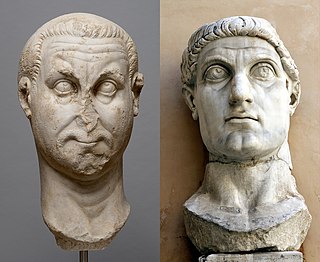
The siege of Byzantium was carried out some time between July and September 324 by the forces of the Roman emperor Constantine I during his Second Civil War against his rival, co-emperor Licinius. It would have been started simultaneously with the naval battle of the Hellespont in which Constantine's son and caesar Crispus defeated the Lycinian navy commanded by Admiral Abanto.

The Battle of Brescia was a confrontation that took place during the summer of 312, between the Roman emperors Constantine the Great and Maxentius in the town of Brescia, in northern Italy. Maxentius declared war on Constantine on the grounds that he wanted to avenge the death of his father Maximian, who had committed suicide after being defeated by him. Constantine would respond with a massive invasion of Italy.




















